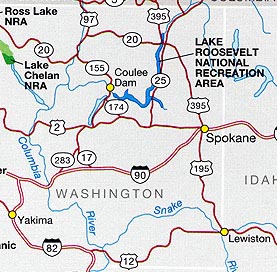In Center for Environmental Law, the 9th Circuit Court of Appeals considered a NEPA challenge by environmental groups to a proposed incremental drawdown of water from Lake Roosevelt in eastern Washington.
 |
| Lake Roosevelt National Recreation Area |
Lake Roosevelt in eastern Washington state serves a variety of purposes, including irrigation, navigation, flood control, power generation, recreation, and fish management.
According to the Court, Plaintiffs' most significant challenge on appeal was Reclamation's cumulative effects analysis in the environmental assessment (EA). The Court characterized this claim as form over substance, as follows:
The record includes extensive evidence that [Reclamation] considered the relevant prior . . . actions and took the requisite hard look before approving the drawdown project. Although this evidence is not presented in the cumulative effects section of the EA, it would impermissibly elevate form over substance to hold that Reclamation must replicate its entire analysis under the heading of cumulative effects.While the Court agreed with Plaintiffs' argument that "the portion of the EA exclusively devoted to cumulative effects is conclusory and unenlightening," Reclamation's analysis was sufficient when "reading the EA as a whole."
In addition to upholding Reclamation's cumulative effects analysis, the Court also upheld its indirect effects and alternatives analysis. In short, the Court opined as follows:
- Indirect Effects. "Agencies need not account for potential growth effects that might be caused by a project if the project is exclusively intended to serve a much more limited need." In this case, "the causal tie between the project and growth is significantly . . . attenuated" with regard to Plaintiffs' claim that the project would cause additional future draw downs. The Court found it significant that "[t]he use of the expanded capacity remains both firmly in the control of Reclamation and is subject to review in a future EA or EIS." Consequently, any environmental effects from additional diversions were not, in the Court's opinion, indirect effects of the current drawdown project.
- Alternatives Analysis. Reclamation’s EA discusses two alternatives—the proposed drawdown and a no action alternative. Plaintiffs' challenged the selection of alternatives as "overly constrained." The Court opined that it has "previously recognized, there is no "numerical floor on alternatives to be considered." In addition, the Court noted prior case law where it previously held that “the absence of a more thorough discussion in [an] EIS of alternatives that were discussed in and rejected as a result of prior state studies does not violate NEPA." Consequently, the Court held that Reclamation's alternatives analysis complied with NEPA. In reaching this conclusion, the Court cited Native Ecosys. Council v. Dombeck, 304 F.3d 886, 897 (9th Cir. 2002), which held that an EA that discussed only the agency’s preferred alternative and a no-action alternative satisfied NEPA. Finally, the Court noted that Reclamation was not required to "consider the alternatives [Plaintiffs] prefer[ed]."
For more on NEPA and environmental assessment issues see, Environmental Law.
No comments:
Post a Comment